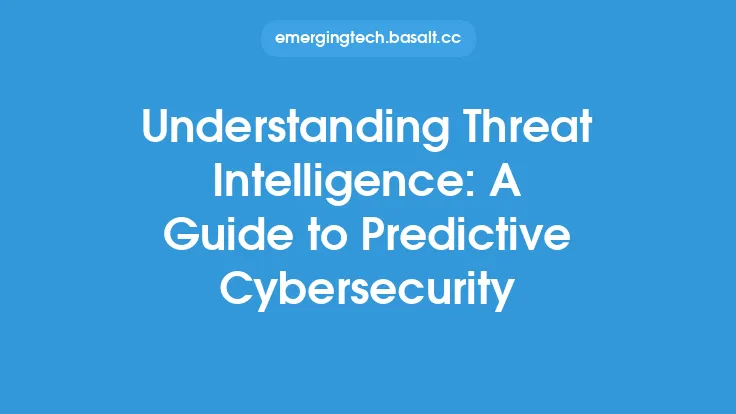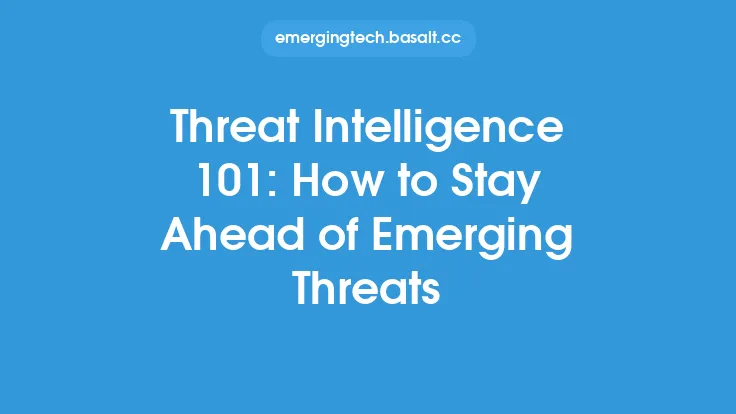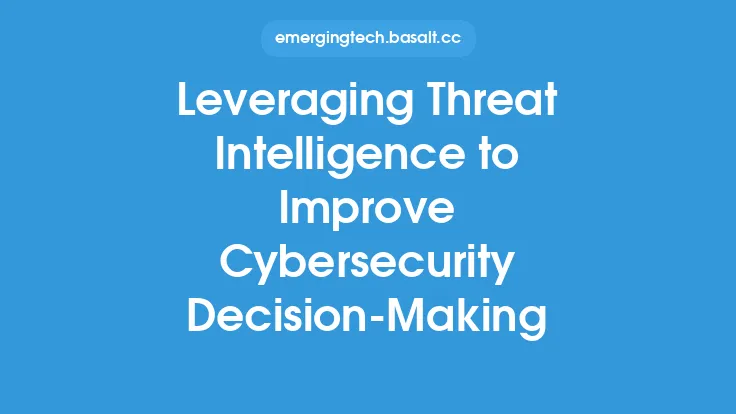In today's digital landscape, cybersecurity is a top priority for organizations of all sizes. The ever-evolving threat landscape, coupled with the increasing sophistication of cyber threats, has made it essential for companies to adopt a proactive approach to cybersecurity. One crucial component of this approach is threat intelligence, which involves gathering, analyzing, and disseminating information about potential or existing cyber threats. Threat intelligence is the key to proactive cybersecurity, enabling organizations to stay one step ahead of cyber threats and prevent attacks before they occur.
What is Threat Intelligence?
Threat intelligence is the process of collecting, analyzing, and disseminating information about potential or existing cyber threats. This information can come from a variety of sources, including open-source intelligence, social media, dark web forums, and human intelligence. Threat intelligence involves analyzing this information to identify patterns, trends, and anomalies that could indicate a potential threat. The goal of threat intelligence is to provide organizations with the information they need to make informed decisions about their cybersecurity posture and to stay ahead of emerging threats.
Types of Threat Intelligence
There are several types of threat intelligence, each with its own unique characteristics and benefits. These include:
- Strategic threat intelligence: This type of intelligence provides a high-level overview of the threat landscape, including trends, patterns, and emerging threats. Strategic threat intelligence is used to inform organizational decisions about cybersecurity strategy and resource allocation.
- Tactical threat intelligence: This type of intelligence provides detailed information about specific threats, including tactics, techniques, and procedures (TTPs) used by attackers. Tactical threat intelligence is used to inform incident response and threat hunting activities.
- Operational threat intelligence: This type of intelligence provides real-time information about ongoing threats, including indicators of compromise (IOCs) and indicators of attack (IOAs). Operational threat intelligence is used to inform security operations and incident response activities.
- Technical threat intelligence: This type of intelligence provides detailed technical information about specific threats, including malware analysis, reverse engineering, and vulnerability research. Technical threat intelligence is used to inform security engineering and research activities.
The Threat Intelligence Lifecycle
The threat intelligence lifecycle is the process by which threat intelligence is collected, analyzed, and disseminated. The lifecycle includes the following stages:
- Planning and direction: This stage involves defining the scope and goals of the threat intelligence program, as well as identifying the sources of intelligence and the methods for collecting and analyzing it.
- Collection: This stage involves gathering intelligence from a variety of sources, including open-source intelligence, social media, dark web forums, and human intelligence.
- Analysis: This stage involves analyzing the collected intelligence to identify patterns, trends, and anomalies that could indicate a potential threat.
- Production: This stage involves creating threat intelligence products, such as reports, briefings, and alerts, to disseminate to stakeholders.
- Dissemination: This stage involves sharing the threat intelligence products with stakeholders, including security teams, incident response teams, and executive leadership.
- Feedback: This stage involves gathering feedback from stakeholders to refine and improve the threat intelligence program.
Threat Intelligence Tools and Techniques
There are a variety of tools and techniques used in threat intelligence, including:
- Threat intelligence platforms: These platforms provide a centralized repository for collecting, analyzing, and disseminating threat intelligence.
- Security information and event management (SIEM) systems: These systems provide real-time monitoring and analysis of security-related data to identify potential threats.
- Intrusion detection systems (IDS): These systems provide real-time monitoring of network traffic to identify potential threats.
- Malware analysis tools: These tools provide detailed analysis of malware samples to identify TTPs and IOCs.
- Reverse engineering tools: These tools provide detailed analysis of software and hardware to identify vulnerabilities and TTPs.
Benefits of Threat Intelligence
The benefits of threat intelligence are numerous, including:
- Improved incident response: Threat intelligence provides organizations with the information they need to respond quickly and effectively to security incidents.
- Enhanced security posture: Threat intelligence provides organizations with the information they need to make informed decisions about their cybersecurity posture and to stay ahead of emerging threats.
- Reduced risk: Threat intelligence provides organizations with the information they need to identify and mitigate potential threats before they occur.
- Increased efficiency: Threat intelligence provides organizations with the information they need to prioritize security efforts and to focus on the most critical threats.
Challenges and Limitations of Threat Intelligence
Despite the benefits of threat intelligence, there are several challenges and limitations to consider, including:
- Data overload: The sheer volume of threat intelligence data can be overwhelming, making it difficult to analyze and disseminate.
- Intelligence sharing: Threat intelligence is often sensitive and proprietary, making it difficult to share with other organizations.
- Talent and resources: Threat intelligence requires specialized talent and resources, which can be difficult to find and retain.
- Integration with existing systems: Threat intelligence often requires integration with existing security systems, which can be difficult and time-consuming.
Best Practices for Implementing Threat Intelligence
To implement threat intelligence effectively, organizations should follow best practices, including:
- Define a clear scope and goals: Organizations should define a clear scope and goals for their threat intelligence program to ensure it is aligned with their overall cybersecurity strategy.
- Identify and prioritize threats: Organizations should identify and prioritize threats based on their likelihood and potential impact.
- Use a variety of sources: Organizations should use a variety of sources, including open-source intelligence, social media, dark web forums, and human intelligence, to gather threat intelligence.
- Analyze and disseminate intelligence: Organizations should analyze and disseminate threat intelligence to stakeholders, including security teams, incident response teams, and executive leadership.
- Continuously monitor and evaluate: Organizations should continuously monitor and evaluate their threat intelligence program to ensure it is effective and efficient.





